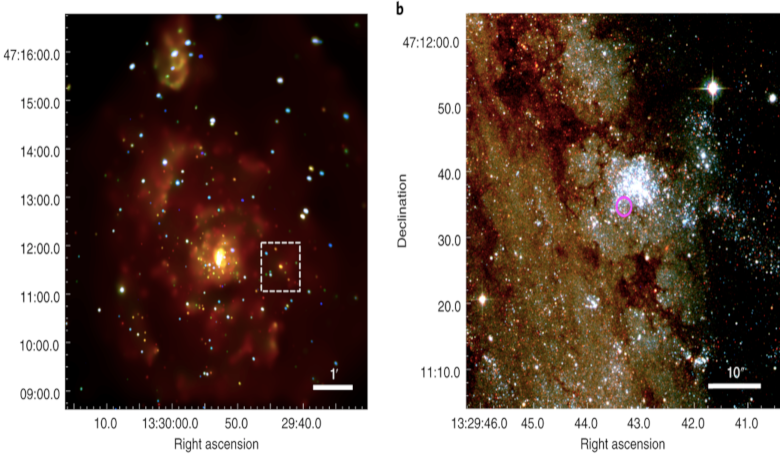A team of astronomers scanning the skies for x-rays might just have found signs of the first exoplanet orbiting a distant binary source in another galaxy.
It stands to reason that our galaxy is not the only galaxy in which planets exist. But spotting planets in other galaxies is incredibly difficult to do. This is because each external galaxy occupies such a small area of the sky and crammed in that far-away pinprick of light is lots of stars.
Picking out one individual star to try and detect the signatures of any orbiting planets, has so far proved futile. One reason this could be is that the methods typically used by astronomers to spot planets in our own Galaxy, through either radial velocity measurements or transit detection techniques, just doesn’t work the same when trying to spot extragalactic exoplanets.
The radial-velocity method for finding exoplanets, or wobble method as it is also known by, relies on detecting minute changes in a star’s orbit caused by the gravitational pull of the smaller planet whizzing around it.
The transit method on the other hand involves monitoring a star to detect periodic dips in its brightness from the planet passing in front of and behind the star.
More exoplanets have been found using the transit method and it is better suited to detecting planets around stars that are located a few thousand light years away than the wobble method, but the transit method also has a high rate of false detections.
What is needed is a new way to narrow the search for extragalactic exoplanets and searching using x-rays is one of the possibilities that Rosanne Di Stefano at the Harvard & Smithsonian Center for Astrophysics, Massachusetts, has been exploring.
"We are trying to open up a whole new arena for finding other worlds by searching for planet candidates at x-ray wavelengths, a strategy that makes it possible to discover them in other galaxies,” Di Stefano says.
The technique used is similar to the transit method, but instead of searching for dips in optical light, Di Stefano and colleagues looked for dips in the brightness of x-rays received from x-ray bright binaries.
These luminous systems typically contain a neutron star or black hole pulling in gas from a closely orbiting companion star. The material near the neutron star or black hole becomes superheated and shoots off x-rays, as the star loses mass. Then, when a planet passes in front of the x-ray-emitting region, it may produce a total or near-total eclipse of the x-rays.
This phenomena is what Di Stefano and colleagues observed after they pointed NASA's Chandra X-ray Observatory at a x-ray binary known as M51-ULS-1.
M51-ULS-1 lies close to the heart of Messier 51 (M51), a spiral galaxy 31 million light years, that is also known as the Whirlpool galaxy.
It is one of three external galaxies, the others being M101 and M104, that Di Stefano and colleagues observed in their search for dips in x-ray luminosity. All in all 238 systems in the three galaxies were observed and only one exoplanet candidate was identified.
The x-ray transit they found from M51-ULS-1 lasted about three hours, during which the x-ray emission decreased to zero.
Based on this and other information, the team estimate the exoplanet candidate is roughly the size of Saturn, and it orbits its larger companion at about twice the distance of Saturn from the Sun.
As tantalising as Di Stefano and team’s result is, they cannot say with 100 percent certainty that its definitely an extragalactic exoplanet. More data would be needed to verify their interpretation of the data, which would be difficult as the planet candidate's large orbit means it would not cross in front of its binary partner again for about 70 years.
"Unfortunately to confirm that we're seeing a planet we would likely have to wait decades to see another transit," said co-author Nia Imara of the University of California at Santa Cruz. "And because of the uncertainties about how long it takes to orbit, we wouldn't know exactly when to look."
The team have considered it might be something else, such as a cloud of gas and dust passing in front of M51-ULS-1, but have ruled it out as the modelled data does not support the findings. The model of a planet candidate is, however, consistent with the data.
"We know we are making an exciting and bold claim so we expect that other astronomers will look at it very carefully," said co-author Julia Berndtsson of Princeton University in New Jersey. "We think we have a strong argument, and this process is how science works."
Moving forward, the team say they will search the archives of both Chandra and XMM-Newton for more exoplanet candidates in other galaxies. Another interesting line of research is to search for X-ray transits from X-ray sources in our own galaxy to discover new nearby planets that might exist in unusual environments.
This research was published this week in Nature Astronomy.











